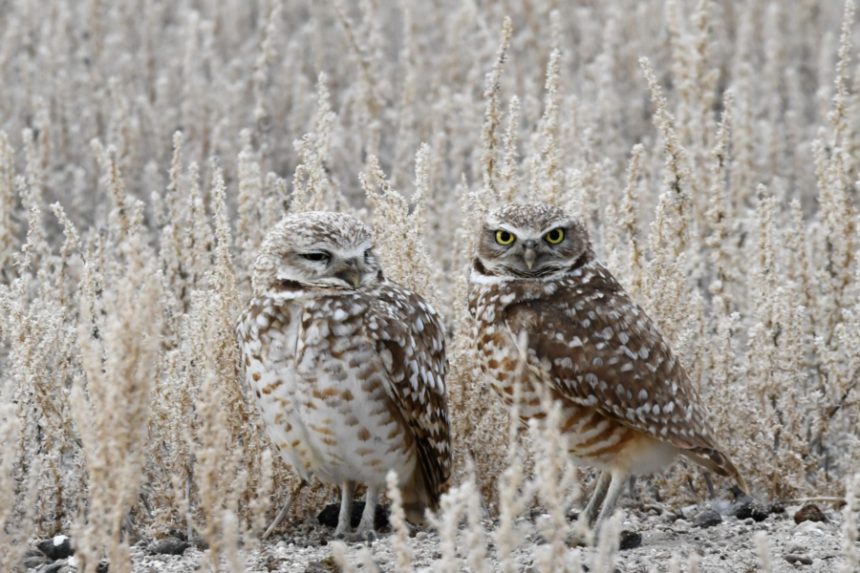 The parents of five owlets that are just learning to fly. | Bill Schiess, EastIdahoNews.com
The parents of five owlets that are just learning to fly. | Bill Schiess, EastIdahoNews.com
As I was driving to a burrowing owl nest for the second time this week, I could not see any activity at it. Two weeks ago, I had observed five owlets along with both parents, actively stretching and running in and out of their main burrow. However, just as I was about to leave, I caught a glimpse of four yellow gems, looking at me through the thick weeds surrounding a secondary burrow.
The wet spring and the recent hot weather had caused the weeds and grass on the small flat to get high enough to hide the secondary holes for them to hide. Three of the owlets were hiding in the weeds surrounding one burrow while two others were about 50 feet at another one.
 Three Burrowing owlets sneak a peek at the photographer as they are trying to hide. | Bill Schiess, EastIdahoNews.com
Three Burrowing owlets sneak a peek at the photographer as they are trying to hide. | Bill Schiess, EastIdahoNews.com While watching and photographing the three, I heard one of the parents calling from a nearby patch of sagebrush. Immediately, one of the three flew over to it while the other two stood up on the burrow mound and appeared to be discussing what they needed to do. Finally, one of the two decided to fly over to the parents while the last one decided to find safety in the burrow. The two in the other burrow also disappeared down their hole.
 Two owlets appear to be discussing what they should do as danger arrives. | Bill Schiess, EastIdahoNews.com
Two owlets appear to be discussing what they should do as danger arrives. | Bill Schiess, EastIdahoNews.com With all the calling back and forth between the family, the ground squirrels paused in their gathering of grass seeds, appearing to wonder about what all the commotion was all about. It did not take long for them to go back to their job of gathering the grass seeds after the hawk, which had caused the warning calls, left. The squirrels would balance on their hind feet and butt while reaching up with their front feet, grab a spire of grass, pull down the seed-laden head and strip it as if it were an ear of corn.
With noon approaching and temperatures reaching into the nineties, the owls had all disappeared for the day. Their feather coats made it a little too warm for them to frolic and play out on the burrow mounds. They probably had their fill of catching and devouring beetles, caterpillars and young flightless grasshoppers; or maybe mom and dad had furnished a hapless rodent for them.
 A ground squirrel looks around as the owl family warns of danger. | Bill Schiess, EastIdahoNews.com
A ground squirrel looks around as the owl family warns of danger. | Bill Schiess, EastIdahoNews.com If you have been watching some ground dwelling owls and they have disappeared, look for some burrows near the area where they were hatched. Soon, each one will have their own hole, but you will have to search during the early morning or late evening. When you find them, you may see they have collected animal dung and placed it around their entrance. They don’t have to pay for doordashing, as the dung attracts insects which the owls feed on without leaving home.
It has been difficult to find a lot of burrowing owls this spring and summer. The late spring may have kept them from moving up from the southern states, as we still had snow when it was time for them to nest. I noticed some came early and then disappeared while many of their nesting areas were still under snow. Also, last summer, many of the owl nests were dug up by badgers before the owlets fledged, and the babies were destroyed.
 A ground squirrel strips a head of grass as if it was a small ear of corn.| Bill Schiess, EastIdahoNews.com
A ground squirrel strips a head of grass as if it was a small ear of corn.| Bill Schiess, EastIdahoNews.com Many places where owls nest are also home to ground squirrels. Right now, I have noticed that the squirrel population is greater than what I have seen it. With only one owl family instead of four or five, the baby squirrels survived to grow up.
If you get a chance to watch both the squirrels and/or the burrowing owls, it can be very entertaining as they both prepare for winter. Now is also the time to watch for hawks and warblers; many start their migration south in late July.
I am kind of like the wildlife – early morning and late evening are my times to get out and enjoy the great outdoors. Good Luck and be safe, we are losing too many young people.
Living the Wild Life is brought to you by The Healing Sanctuary.


















 English (United States) ·
English (United States) ·